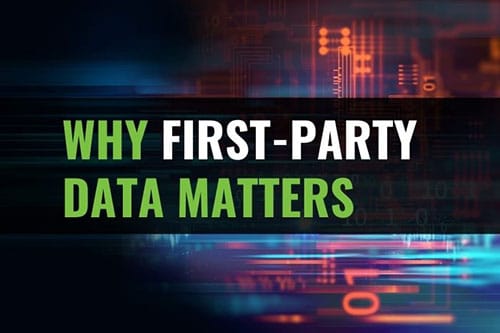Why First-Party Data Matters

Data is and will continue to be critical in the marketing world. It provides valuable insights that can be used to make better decisions. It can be leveraged strategically to identify consumer behaviors, uncover purchasing patterns, develop effective messaging and target prospective customers accurately. Plain and simple, effectively utilizing data improves marketing efforts and return on investment (ROI).
However, recent changes to privacy regulations and technology platforms have made the future of certain kinds of data uncertain. This highlights the importance of understanding the types of data you use, how it is collected and how you manage and use it. By ensuring that you have the right data, you can position your marketing and business for success in the years to come.
Types of Marketing Data
First-party data is information collected directly from your audience on properties (digital or non-digital) you own and have direct access to. It includes data about behaviors, actions or interests. First-party data includes information from your customer relationship management (CRM) tools and subscription data for emails, podcasts, texts or other marketing lists you own and manage. It can also include data from your social media channels or non-digital information like survey results, customer feedback or other customer information. It is important to store data collected from social media channels and other platforms in a secure location that you own. Otherwise, you may lose access to that data if you lose access to the platform.
Second-party data is essentially first-party data that two or more parties agree to share for mutual benefit. In this article, however, we’ll focus on first and third-party data.
Third-party data is data that you can acquire or access through outside sources that are not the original collectors of that data. It is pulled from various platforms and websites where it was gathered using cookies and other similar methods. Third-party data collectors might pay publishers and other data owners for their data. This data is aggregated and sorted in various categories and segments. Then, access to that data is sold to interested parties. One of the most common uses of third-party data is to build audiences that can be targeted programmatically with digital advertisements.
First-Party Data vs. Third-Party Data
First-party data is typically more relevant and accurate than third-party data because it comes straight from your audience or customers. It’s also available with no outside or markup costs, meaning the potential for a stronger ROI. With first-party data, there are fewer privacy concerns because you own it. It is collected when a customer or member of your audience voluntarily engages with your brand and/or digital properties.
Since third-party data is collected indirectly and processed, it typically isn’t as specific or valuable. However, it can be good for reaching new audiences, spreading awareness to larger audiences or as a replacement for first-party data if you haven’t collected any yet.
Why First-Party Data Matters
For years, adept digital marketers have been strategically using both types of data to be more efficient with their marketing dollars and improve ROI. However, in recent years, privacy has become a bigger talking point with both regulations and technology platforms. This has changed how data is collected and has made the future of third-party data less certain.
Major browsers have begun blocking cookies and other tracking methods that third-party data providers rely on to collect accurate data. The latest version of Apple’s mobile operating system, iOS 14.5, recently launched with a new privacy feature called App Tracking Transparency (ATT). This means iPhone users will start seeing more privacy prompts as they continue using their regular apps, with more options to opt-out of tracking. Although there are replacements being developed like Google’s FLoC and other alternative solutions being tested, there is no one sure replacement solution for collecting third-party data.
So what does this all mean? It means collecting, organizing, managing and utilizing first-party data is going to become more important than ever before. Remaining aware of the changing environment and building out your own first-party data set needs to be a big priority for your brand, right now.
Leveraging first-party data to its fullest extent can give you a big advantage over your competition in the coming years. Not only will your data be more accurate, but you’ll get to know your customers and audience better in the process. Research, data and insight are key ingredients to marketing success. Are you making the most of the opportunities available to leverage first-party data to build your brand and business?
Additional resources with more information:

